skip to main |
skip to sidebar
I was inspired to make these baked vadas – or rather, reminded that such a thing existed on my blog – by a new friend based in Australia when she wrote to me saying that she had made the vadas (adding flaxseed as per the original recipe on The Taste Tinkerer’s blog). That’s when I suddenly remembered how LOVELY the baked vadas had tasted and wondered why on earth (and how on earth too) I’d not made them in such a long time!
And naturally I wanted them immediately (or as close to immediately as I could get) – so I ended up soaking the dals at around 10.30 p.m, just as Pete was delicately putting forward a suggestion of retiring to bed. But I wasn’t sleepy – no, the Sandman had been pushed into the background (and was probably sulking at being so rudely dismissed). I wanted to make those vadas there and then. Also, I was thrilled that I had flaxseeds at hand… and when you’re in the grip of a sudden obsession backed by having all the requisite ingredients – well, ya gotta do what ya gotta do, as they say.
By the way, I soaked the dals in very hot water for quick results because of the lateness of the hour, but the preferable method is to soak the dals in water for a few hours so that they rehydrate naturally.
So by 11 p.m, I was doing what I hadda do with the soaked dals, adding finely shredded cabbage as well as onions to make the batter... and 15 minutes later, the Sandman had officially given up on Pete as well, as he (Pete) had been awakened well and truly by the AMAZING aroma of the baking vadas that was wafting around the house.
By 11.40 p.m or so, I was taste-testing very hot baked masala vadas fresh from the oven, while Pete watched me somewhat grumpily – he was left out of the whole vada love-fest because they contained (to him) insane amounts of fresh chillies. Well, how was I to know he’d want some too?
But don’t worry, gentle reader… I satisfied his suddenly-awakened vada craving the next evening by baking some more vadas just for him at a reasonable hour of the evening, to the general satisfaction and happiness of all concerned (the Sandman included).
Recipe for: Baked cabbage-onion masala vada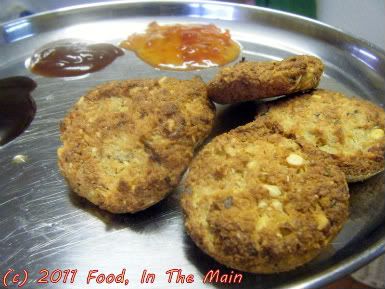
Ingredients:
1/2 cup chana dal
1/2 cup toor dal
1/3 cup flax seeds
1/3 cup red onion, chopped
1/3 cup green cabbage, shredded
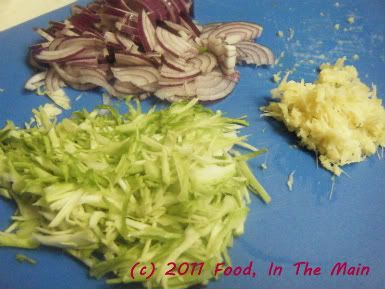
3-5 fresh green/red chillies
3-4 tbsp roasted peanuts, coarsely crushed
1" piece ginger
a few curry leaves, torn up (optional)
1 tsp baking powder
1 tbsp oil
Salt to taste
Oil-spray/Pam
1. Soak the chana dal and toor dal for 3-4 hours.
2. Grind a handful of the dals along with the flax seeds, red chillies and ginger to a smooth paste, adding a little water.
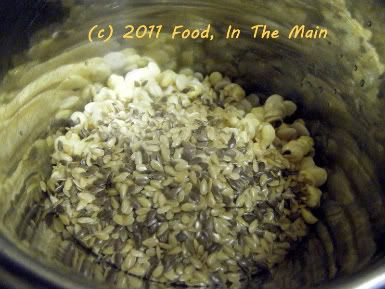
3. Next, add the remaining dal, the red onion and cabbage and grind to a coarse consistency using as little water as possible. The batter must be thick enough to hold its shape when made into patties.
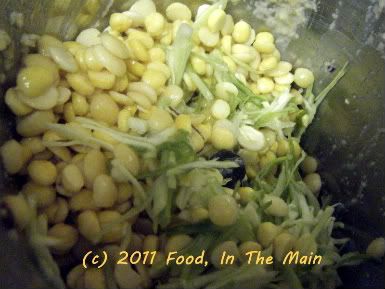
4. Turn the batter out into a bowl and add the 1 tbsp oil, salt to taste, peanuts and 1 tsp baking powder. Stir thoroughly to ensure the ingredients are mixed in evenly.
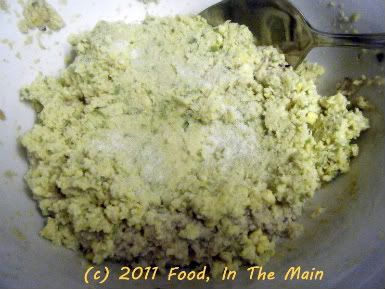
4. Grease a small cupcake or mini-muffin tray, then place lime-sized pieces of the batter in the depressions, patting them level with the top of the tray.
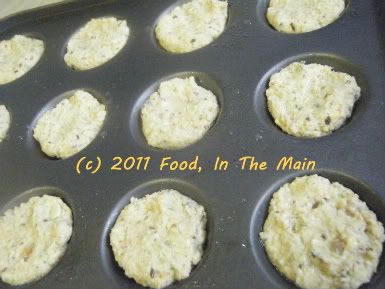
5. Heat the oven to 180C/350F. Spray the tops of the batter with Pam or brush lightly with oil, and bake for 15-20 minutes in the middle of the oven, turning the tray around mid-way. When the vadas are golden brown on top, turn off the heat.
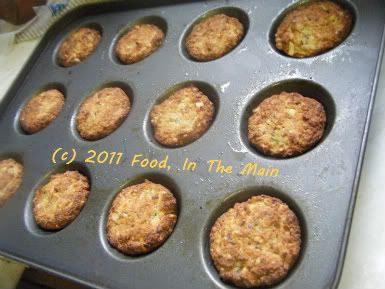
Let the vadas remain in the tray for 5 minutes, then turn them out. Serve hot as a snack with dips or chutney. These are best eaten hot and fresh, as they tend to become somewhat dry the next day and aren't as much fun to eat as a snack.
RECIPE: BAKED CABBAGE-ONION MASALA VADA
Ingredients:
1/2 cup chana dal
1/2 cup toor dal
1/3 cup flax seeds
1/3 cup red onion, chopped
1/3 cup green cabbage, shredded
3-5 fresh green/red chillies
3-4 tbsp roasted peanuts, coarsely crushed
1" piece ginger
a few curry leaves, torn up (optional)
1 tsp baking powder
1 tbsp oil
Salt to taste
Oil-spray/Pam
Method:
1. Soak the chana dal and toor dal for 3-4 hours.
2. Grind a handful of the dals along with the flax seeds, red chillies and ginger to a smooth paste, adding a little water.
3. Next, add the remaining dal, the red onion and cabbage and grind to a coarse consistency using as little water as possible. The batter must be thick enough to hold its shape when made into patties.
4. Turn the batter out into a bowl and add the 1 tbsp oil, salt to taste, peanuts and 1 tsp baking powder. Stir thoroughly to ensure the ingredients are mixed in evenly.
5. Grease a small cupcake or mini-muffin tray, then place lime-sized pieces of the batter in the depressions, patting them level with the top of the tray.
6. Heat the oven to 180C/350F. Spray the tops of the batter with Pam or brush lightly with oil, and bake for 15-20 minutes in the middle of the oven, turning the tray around mid-way. When the vadas are golden brown on top, turn off the heat.
7. Let the vadas remain in the tray for 5 minutes, then turn them out. Serve hot as a snack with dips or chutney. These are best eaten hot and fresh, as they tend to become somewhat dry the next day and aren't as much fun to eat as a snack.
Cassava/tapioca is one of the many root vegetables I like because of its association with the years that I lived in Dar-es-Salaam as a kid. I mainly knew it in its roasted or fried form, although I also liked its boiled and salted avatar. I’d seen recipes for cassava from fresh, but never any for dried cassava.
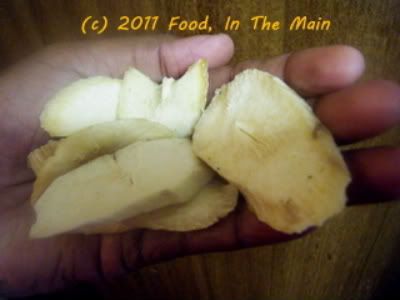
I'd come into possession of dried cassava pieces a few weeks ago, when I had tagged along with Pete to York (or somewhere thereabouts) where he was to meet someone to collect some esoteric sound equipment. The ride was itself worth it for the scenery, but even better was the fact that the meeting point turned out to be right next to a reasonably big “Indian” store – well, it was actually an Iraqi store, but it contained enough Indian/Mediterranean/Middle-Eastern stuff to make me happy.
I wanted to explore the shop, but Pete said his contact would be there imminently and the whole exchange wouldn’t take 5 minutes, so I resigned myself to a quick trip into the store to get some whole urad dal which I’d run out of. I saw plenty of interesting things in there to make me wish I could browse for a bit, but I didn’t hang around as we had a 3-hour drive back to Shrewsbury (and I was working the next day, so it was in my best interests to get back home as soon as possible) - and I was on a promise to my husband, in any case.
I believe that keeping my virtuous promise to Pete (“I’ll only be a minute at the shop, honest” - which he didn’t really believe since he knew what I was like) was instantly rewarded in the form of a serendipitous call from Pete’s contact to say that he was running late by about 30-40 minutes. I must have lit up the street with my delighted smile, because my husband gave me a grin and said “Oh all right, go on with you, only don’t buy up the shop will ya?”
I didn’t buy up the shop, but I did have a thoroughly enjoyable time browsing every aisle and its contents, trying to figure out what the items were (made somewhat difficult because sometimes I didn’t know the script or the language), and finding things to buy that I didn’t know I wanted to try until I saw them. Among other, more mundane things, I bought two (to me) exotic items - a bag of dried cassava/tapioca pieces, and something called “mograbiyeh”, made of semolina (which Google revealed later was like couscous, except the grains were the size of peppercorns).
I reserved the mograbiyeh for later and decided to experiment with the dried cassava/tapioca first. To be honest, I didn’t have the first idea what to make with it, but I figured Step 1 would be to rehydrate them. So I turned out a third of the bag into a bowl of water and let it soak overnight. I still didn’t know what Step 2 ought to be, and Google didn’t really suggest any recipes specifically using dried cassava.
I decided to bake the rehydrated pieces (which, I assumed, had been originally cooked and then dried) in the oven, because I really do love cassava chips and I had my Dar-es-Salaam memories in mind. Sadly, they mostly turned into baked wood chips and had to be consigned to the bin, my teeth not being what they once were.
My second experiment was to soak and then deep-fry the pieces to see if that would make better chips. The experiment was a success in a way, because the end result was definitely better wood chips; but in terms of edibility, not so much. My teeth continued to be not what they once were.
Now there was only the final third of the bag left to play around with, and I decided that the only thing to do now was improvise a curry. So I did. And here it is in recipe form, in all its successful glory.
Recipe for: Cassava/tapioca in flaxseed masala
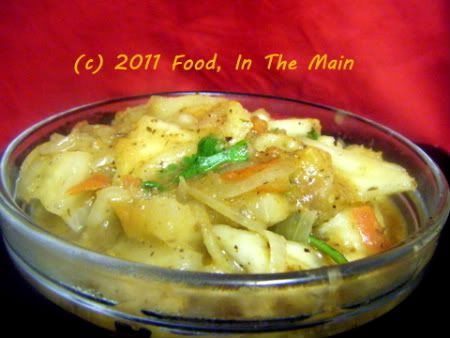 Ingredients:
Ingredients:
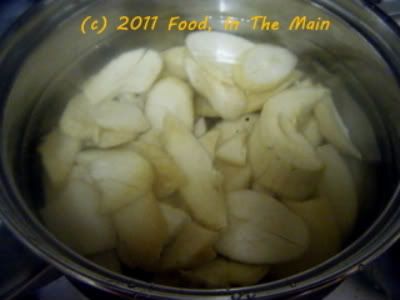 1 cup dried cassava/tapioca pieces, soaked in water for 3-4 hours
1 tbsp flaxseeds
6-7 black peppercorns
1/2 tsp cumin seeds
1/2 tsp coriander seeds
2 cloves garlic
4-5 dry red chillies (or to taste)
1/2 tsp tamarind paste
2 medium onions, sliced thin
1 cup chopped tomatoes
1/2 tsp garam masala (I used Kitchen King)
1 tbsp oil
Salt to taste
Coriander leaves to garnish
Method:
1. Break up the soaked cassava/tapioca pieces into more or less even bits. Boil them in water until they are cooked. They should be very soft (easily pierced with a knife tip) but not mushy.
1 cup dried cassava/tapioca pieces, soaked in water for 3-4 hours
1 tbsp flaxseeds
6-7 black peppercorns
1/2 tsp cumin seeds
1/2 tsp coriander seeds
2 cloves garlic
4-5 dry red chillies (or to taste)
1/2 tsp tamarind paste
2 medium onions, sliced thin
1 cup chopped tomatoes
1/2 tsp garam masala (I used Kitchen King)
1 tbsp oil
Salt to taste
Coriander leaves to garnish
Method:
1. Break up the soaked cassava/tapioca pieces into more or less even bits. Boil them in water until they are cooked. They should be very soft (easily pierced with a knife tip) but not mushy.
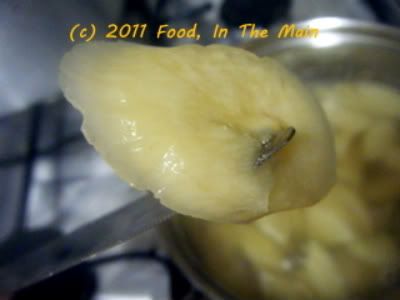 Drain and reserve.
2. Grind the flaxseeds, peppercorns, cumin seeds, coriander seeds, garlic and red chillies to a fairly smooth paste, without adding water.
Drain and reserve.
2. Grind the flaxseeds, peppercorns, cumin seeds, coriander seeds, garlic and red chillies to a fairly smooth paste, without adding water.
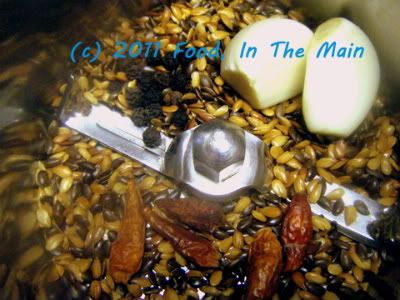 3. Heat the oil in a pan and fry and ground masala paste for 1 minute, stirring briskly.
4. Add the sliced onions and fry for 3-4 minutes, or until they start to turn translucent.
3. Heat the oil in a pan and fry and ground masala paste for 1 minute, stirring briskly.
4. Add the sliced onions and fry for 3-4 minutes, or until they start to turn translucent.
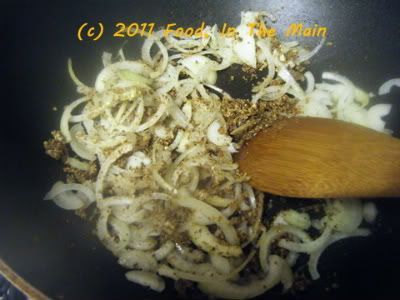 5. Now add the tomatoes and stir them in.
5. Now add the tomatoes and stir them in.
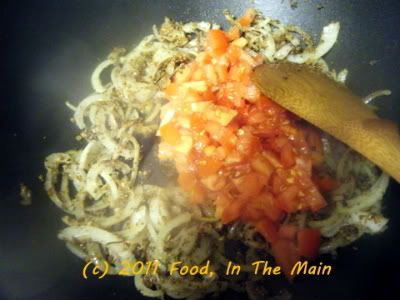 Let them cook down with the onions until mushy.
Let them cook down with the onions until mushy.
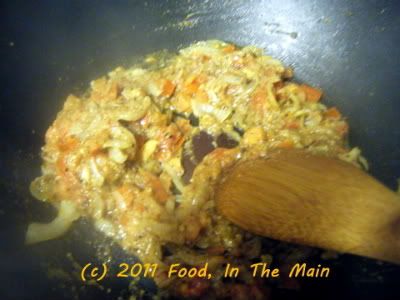 6. Next, add the cooked cassava/tapioca pieces
6. Next, add the cooked cassava/tapioca pieces 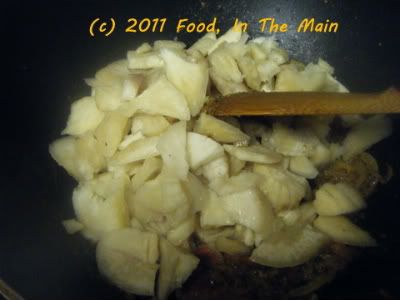 and mix them with the tomato-onion masala.
and mix them with the tomato-onion masala.
 7. Dissolve the tamarind paste in 1-1/2 cups water and pour it in. Stir well and add salt to taste.
7. Dissolve the tamarind paste in 1-1/2 cups water and pour it in. Stir well and add salt to taste.
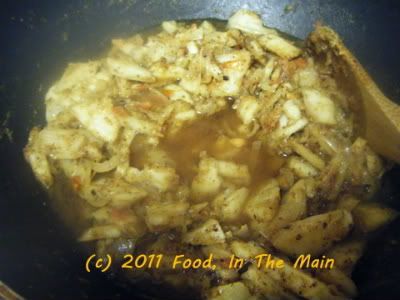 8. Bring to a gentle boil, then turn down the heat and let the curry simmer for 5 minutes while the gravy thickens.
8. Bring to a gentle boil, then turn down the heat and let the curry simmer for 5 minutes while the gravy thickens.
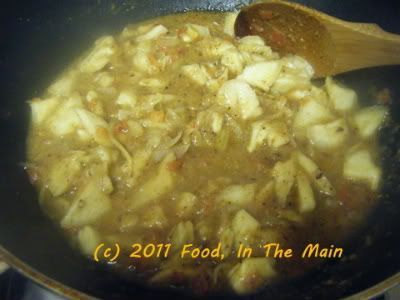 Garnish with coriander leaves before serving hot with cooked millet or quinoa. Can also be eaten with chapaties/rotis.
RECIPE: CASSAVA/TAPIOCA IN FLAXSEED MASALA
Ingredients:
1 cup dried cassava pieces, soaked in water for 3-4 hours
1 tbsp flaxseeds
6-7 black peppercorns
1/2 tsp cumin seeds
1/2 tsp coriander seeds
2 cloves garlic
4-5 dry red chillies (or to taste)
1/2 tsp tamarind paste
2 medium onions, sliced thin
1 cup chopped tomatoes
1/2 tsp garam masala (I used Kitchen King)
1 tbsp oil
Salt to taste
Coriander leaves to garnish
Method:
1. Break up the soaked cassava/tapioca pieces into more or less even bits. Boil them in water until they are cooked. They should be very soft (easily pierced with a knife tip) but not mushy. Drain and reserve.
2. Grind the flaxseeds, peppercorns, cumin seeds, coriander seeds, garlic and red chillies to a fairly smooth paste, without adding water.
3. Heat the oil in a pan and fry and ground masala paste for 1 minute, stirring briskly.
4. Add the sliced onions and fry for 3-4 minutes, or until they start to turn translucent.
5. Now add the tomatoes and stir them in. Let them cook down with the onions until mushy.
6. Next, add the cooked cassava/tapioca pieces and mix them with the tomato-onion masala.
7. Dissolve the tamarind paste in 1-1/2 cups water and pour it in. Stir well and add salt to taste.
8. Bring to a gentle boil, then turn down the heat and let the curry simmer for 5 minutes. Garnish with coriander leaves before serving hot with cooked millet or quinoa. Can also be eaten with chapaties/rotis.
Garnish with coriander leaves before serving hot with cooked millet or quinoa. Can also be eaten with chapaties/rotis.
RECIPE: CASSAVA/TAPIOCA IN FLAXSEED MASALA
Ingredients:
1 cup dried cassava pieces, soaked in water for 3-4 hours
1 tbsp flaxseeds
6-7 black peppercorns
1/2 tsp cumin seeds
1/2 tsp coriander seeds
2 cloves garlic
4-5 dry red chillies (or to taste)
1/2 tsp tamarind paste
2 medium onions, sliced thin
1 cup chopped tomatoes
1/2 tsp garam masala (I used Kitchen King)
1 tbsp oil
Salt to taste
Coriander leaves to garnish
Method:
1. Break up the soaked cassava/tapioca pieces into more or less even bits. Boil them in water until they are cooked. They should be very soft (easily pierced with a knife tip) but not mushy. Drain and reserve.
2. Grind the flaxseeds, peppercorns, cumin seeds, coriander seeds, garlic and red chillies to a fairly smooth paste, without adding water.
3. Heat the oil in a pan and fry and ground masala paste for 1 minute, stirring briskly.
4. Add the sliced onions and fry for 3-4 minutes, or until they start to turn translucent.
5. Now add the tomatoes and stir them in. Let them cook down with the onions until mushy.
6. Next, add the cooked cassava/tapioca pieces and mix them with the tomato-onion masala.
7. Dissolve the tamarind paste in 1-1/2 cups water and pour it in. Stir well and add salt to taste.
8. Bring to a gentle boil, then turn down the heat and let the curry simmer for 5 minutes. Garnish with coriander leaves before serving hot with cooked millet or quinoa. Can also be eaten with chapaties/rotis.
This is the third recipe using flaxseeds that I'm posting here in as many weeks... I haven't gone totally flaxseed crazy, honest. I do have other posts to write, and I have made other things (NOT using flaxseeds!) that need to be posted on my blog. But I'm still feeling an inexplicable antipathy to editing the darn photos, especially if there are lots of photos to choose from, and lots of photos to use with each recipe. Part of the problem is having to use a new photo editing tool (Picnik, free and online, which Nupur mentioned in a comment and which I latched on to quicker than quick) which seems slower than what I was using. Not that Picnik is difficult to use, it's just different... and yes, I'm just cribbing because I can... simbly only.
So yeah, before my solitary (but persistent) troll, who has cribbed before about the number and the quality of pics I use for each recipe, suggests that I use NO pix at all and thus resolve my anti-editing issues, I hasten to say that YES, that would be one solution. The other solution would be to perhaps cut down on the number of pics for each recipe... but I'm averse to doing that too. What I need is for someone to take over and kindly edit my photos. Actually what I need is someone who will take AND edit the photos, thereby hopefully making my blog a thing of beauty... but sadly that is not going to happen any time soon. *deep sigh* So until then I'm going to be posting recipes which have only a few instructions, and therefore only a few photos!
So, about today's recipe - the upma is really quite nice. But I'd probably powder the roasted flaxseeds next time, so as to release their aroma and flavour. (This is an older recipe than the previous one, and I hadn't discovered that powdered roasted flaxseeds are far superior in taste and aroma!)
PS. If you're wondering why there are no trolly comments to be seen on any of my posts, it's because I delete them. Not because they're critical of my efforts, but because the troll chooses to stay anonymous. I'll be damned if I let a coward take up any space on my blog.
Recipe for: Flaxseed aval/poha upma
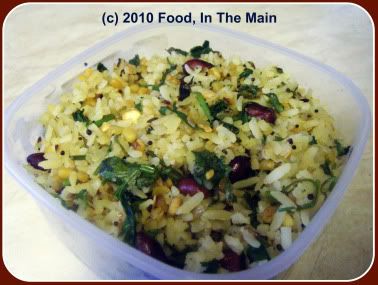
Ingredients:
1 cup aval/poha/beaten rice
2 tbsp golden flaxseeds/linseeds
1 tsp chana dal
1 tsp urad dal (I used whole)
1 medium onion, chopped finely
3-4 green chillies (or to taste), sliced finely
3 tsp oil
2 tbsp chopped coriander leaves
Handful of red peanuts with skin
salt to taste
lemon juice to taste
Method:
1. Soak the chana dal and urad dal in hot water for 15 minutes.
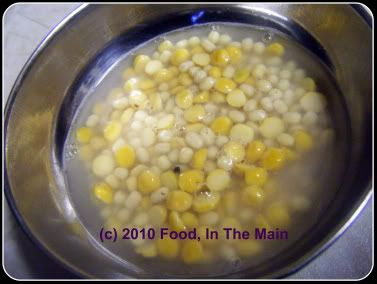
2. Rinse the aval/poha in water once or twice, sprinkle with 3-4 tbsp water and set aside covered so that the aval can absorb the water and rehydrate. The soaked aval/poha should be soft but not gooey or sticky.
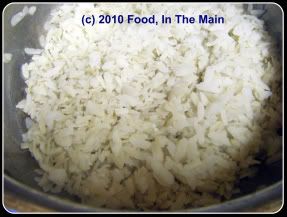
3. Heat 2 tsp oil in a pan and add the asafoetida powder, mustard seeds and green chillies. Cover the pan and let the mustard seeds pop. Add the chana and urad dals (drained), and fry them for 3-4 minutes. Then add the chopped onions and stir-fry till they are soft and cooked.
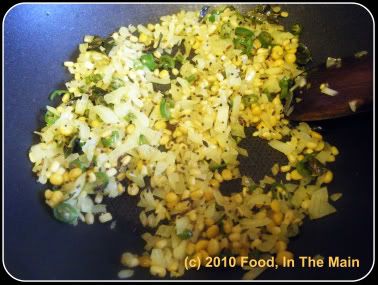
4. Add the soaked softened aval/poha to the pan and stir it in.
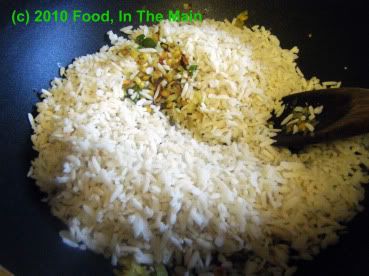
5. Add the dry-roasted linseeds/flaxseeds and mix that in as well, along with salt to taste.
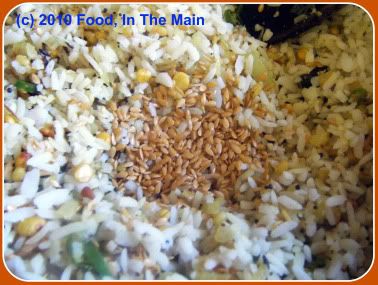
and the chopped coriander. Sprinkle lemon/lime juice to taste and mix it in.
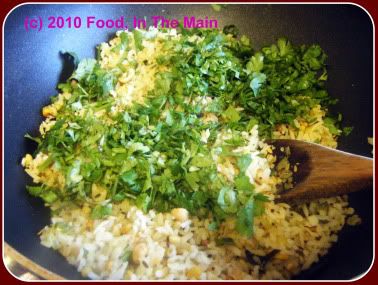
6. Fry the peanuts separately in the remaining tsp oil till they emit a nice aroma and the skin turns a shiny dark red. Scatter them over the poha and serve the finished upma for a snack or a light meal.
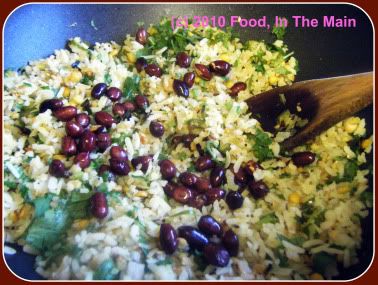
Why didn’t anybody tell me that linseeds (or flaxseeds, which is their other name) were so incredibly aromatic and tasty when roasted and powdered? All this while I’d been – well, not exactly put off by flaxseeds, but sort of avoiding them because they had this label of “health food”. The product information on the packs said I could add the seeds to salads or cereals or yogurt – none of which really appealed to me.
But I went ahead and bought a pack the other week, despite not quite knowing what to really do with the seeds. The first couple of times I added a tablespoon of the linseeds to my cereal, as per the suggestions on the pack. The seeds tasted ok, but I didn’t find them particularly moreish. Then I thought that perhaps roasting them would help – they tasted better, but there was no particular change in the aroma of the finished dish.
And then, while making a batch of paruppu podi, I decided to dry-roast some flaxseeds along with the dals and powder them. I knew that at the very least they wouldn’t add a nasty taste, and at best they would be an added health boost to a protein-rich powder. Again, no particular change in the aroma of the paruppu podi, not even when the dals and seeds were being milled into powder.
But when I had the podi with rice and a bit of ghee one night, I was completely surprised by the amazing taste! Yes, paruppu podi is an aromatic, tasty preparation, especially mixed with some ghee added to hot white rice... but this was something else again. I wasn’t entirely sure what I’d done for it to have the extra oomph, until I remembered the linseeds. Surely they couldn’t have been the reason?
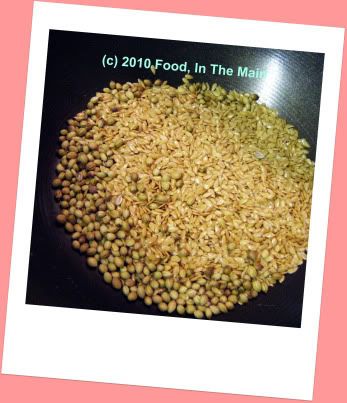
Of course I had to double-check this... so I roasted 3 tbsp of linseeds with 3 tbsp coriander seeds (and I would have roasted 2 tbsp urad dal with this, but I had store-bought roasted urad dal powder to use up) and cooled and powdered them.... and ohhh yeah! The linseeds finally came into their own, with a flavour reminiscent of roasted sesame seeds, but not as strong.
I made spiced rice with this powder for Pete and me that night to go with our special egg curry dinner, and he absolutely loved it.
A latecomer I might be to the delights of flax seeds, but now that I’m finally on board, it's going to be flaxseeds, flaxseeds all the way!
Recipe for: Flaxseed/linseed powder spiced rice
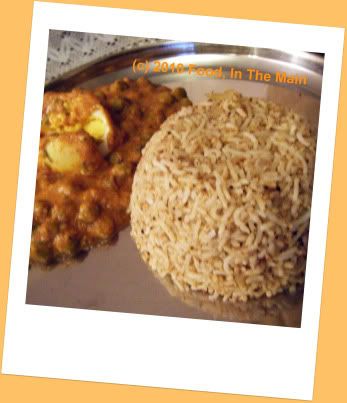
Ingredients:
3 tbsp coriander seeds
3 tbsp golden flax seeds
2 tbsp urad dal
2 dried red chillies (optional, or to taste)
1 medium onion, chopped fine
2 tsp mustard seeds
a few curry leaves (fresh or frozen)
1/4 tsp hing/asafoetida powder
Salt to taste
1 tbsp oil
4 cups cooked rice
Method:
1. On medium heat, dry roast the coriander seeds, urad dal, flax seeds and red chillies till the seeds are a darker shade and the urad dal is golden.
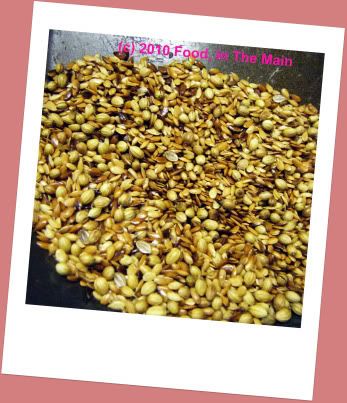
Cool and powder finely. (If you are using ready-bought roasted urad dal powder like I did, mix 2 tbsp of this after grinding the roasted coriander-flaxseeds).

Reserve.
2. Heat the oil in a large pan and add the asafoetida powder, mustard seeds and curry leaves. Cover the let the mustard seeds pop.
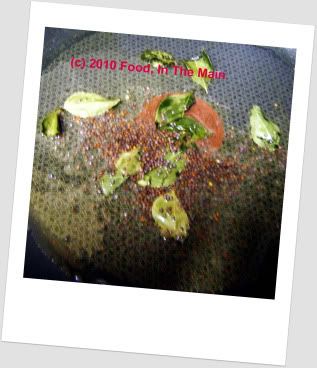
3. Add the finely chopped onions and fry them on med-low heat till they are translucent and soft.
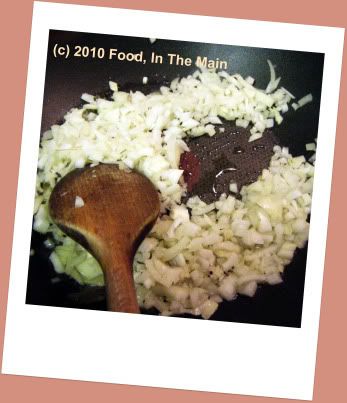
4. Add the cooked rice to the softened onions and mix it in carefully.
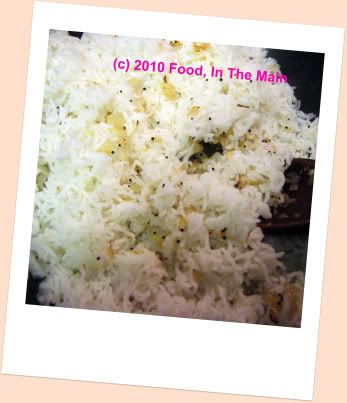
5. Now sprinkle 3 tbsp of the roasted flaxseed-coriander powder along with salt to taste on the rice
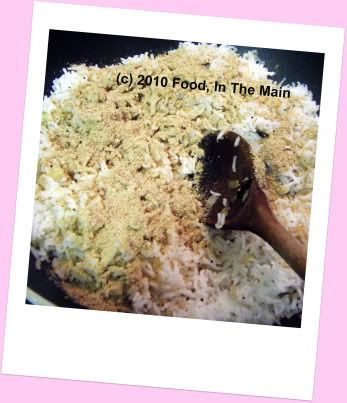
and mix till well amalgamated, taking care not to break the rice grains. Taste and check to see if more powder needs to be added.
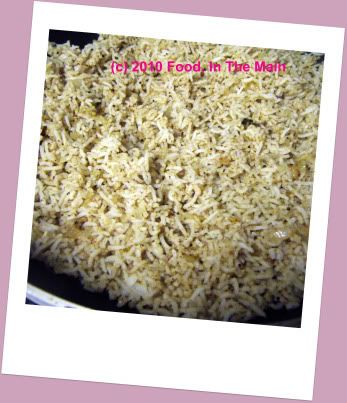
Make sure the rice is thoroughly heated, then serve hot with a gravy curry, or with a dry curry and a raita, or even by itself with something crunchy on the side.





































